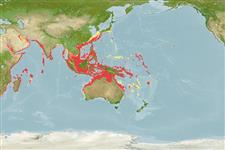Preferred temperature (Ref.
123201): 22.4 - 28.4, mean 26.9 °C (based on 1165 cells).
Índice de diversidade filogenética (Ref.
82804): PD
50 = 0.5000 [Uniqueness, from 0.5 = low to 2.0 = high].
Bayesian length-weight: a=0.01096 (0.00797 - 0.01509), b=3.00 (2.91 - 3.09), in cm total length, based on LWR estimates for this species (Ref.
93245).
Nível Trófico (Ref.
69278): 3.7 ±0.3 se; based on diet studies.
Resiliência (Ref.
120179): Baixo, tempo mínimo de duplicação da população 4,5 - 14 anos (K=0.31; tm=2; tmax=25; Fec = 22,128).
Prior r = 0.28, 95% CL = 0.19 - 0.42, Based on 2 data-limited stock assessments.
Fishing Vulnerability (Ref.
59153): High vulnerability (61 of 100).
🛈
Climate Vulnerability (Ref.
125649): Moderate to high vulnerability (54 of 100).
🛈
Nutrients (Ref.
124155): Calcium = 25.8 [12.1, 55.4] mg/100g; Iron = 0.471 [0.250, 0.945] mg/100g; Protein = 18.2 [16.7, 19.7] %; Omega3 = 0.134 [0.085, 0.211] g/100g; Selenium = 43 [25, 75] μg/100g; VitaminA = 209 [60, 730] μg/100g; Zinc = 1.38 [0.96, 1.91] mg/100g (wet weight);
